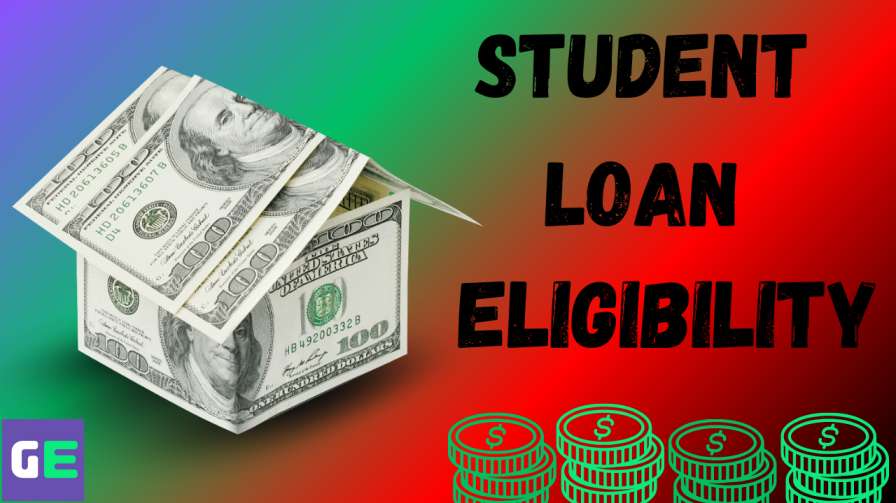1. Introduction
- Overview of the Importance of Student Loans: Student loans are a crucial financial resource for many students seeking higher education. They help bridge the gap between personal savings, scholarships, and the total cost of education, making college accessible to a broader population.
- Purpose of the Guide: This guide aims to provide a comprehensive understanding of student loan eligibility, helping prospective borrowers navigate the requirements and application process to secure the financial aid they need.
2. Types of Student Loans
- Federal vs. Private Student Loans: Federal student loans are funded by the government and typically offer lower interest rates and more flexible repayment options compared to private loans, which are provided by banks and other financial institutions.
- Subsidized vs. Unsubsidized Loans: Subsidized loans are need-based, with the government paying the interest while the student is in school. Unsubsidized loans are not need-based, and interest accrues from the time the loan is disbursed.
- PLUS Loans and Other Specialized Loan Types: PLUS loans are available to graduate students and parents of undergraduates. Other specialized loans may include Perkins Loans and institutional loans offered by specific schools.
3. General Eligibility Requirements
- Citizenship and Residency Status: To be eligible for federal student loans, applicants must be U.S. citizens or eligible non-citizens. Detailed information can be found on the Federal Student Aid website.
- Enrollment Status (Half-Time or Full-Time): Students must be enrolled at least half-time in an eligible degree or certificate program to qualify for most federal loans.
- Accredited Institutions: Loans are only available for programs at accredited institutions recognized by the U.S. Department of Education.
4. Federal Student Loan Eligibility
- Completing the FAFSA: The Free Application for Federal Student Aid (FAFSA) is the first step in determining eligibility for federal student loans. More information on filling out the FAFSA can be found here.
- Financial Need Assessment: Eligibility for subsidized loans and other need-based aid is determined by the student’s financial need, which is calculated based on the information provided in the FAFSA.
- Academic Progress Requirements: Students must maintain satisfactory academic progress as defined by their school to remain eligible for federal aid.
- Loan Limits and Dependency Status: Federal student loan eligibility includes annual and aggregate loan limits, which vary based on the student’s year in school and dependency status. Details on these limits can be found here.
5. Private Student Loan Eligibility
- Credit Score Requirements: Unlike federal loans, private student loan eligibility often depends on the applicant’s credit score. Lenders look for good to excellent credit.
- Income and Employment Criteria: Some private lenders may require proof of income or employment.
- Co-Signer Considerations: Many students may need a co-signer with a strong credit history to qualify for private loans.
- Comparison with Federal Loan Eligibility: Private loans can offer higher borrowing limits but usually come with higher interest rates and fewer repayment options compared to federal loans.
6. Special Circumstances and Eligibility
- Non-Traditional Students: Students returning to school after a break, working students, or those attending non-degree programs might have different eligibility criteria.
- Part-Time Students: Part-time students may still qualify for loans, but the amount may be reduced.
- Graduate and Professional Students: These students often have access to different types of federal loans, such as PLUS loans, and may have higher loan limits.
- International Students: International students typically are not eligible for federal loans but may qualify for private loans with a U.S. co-signer.
7. Maintaining Loan Eligibility
- Satisfactory Academic Progress: Schools define specific academic criteria that students must meet to maintain eligibility for federal aid. More details can be found on your institution’s financial aid office website.
- Enrollment Status Maintenance: Students must maintain at least half-time enrollment to remain eligible for most federal loans.
- Loan Repayment and Deferment Options: Understanding the repayment plans and deferment options available for federal loans can help maintain good standing and avoid default. Information on repayment plans is available here.
8. Common Pitfalls and How to Avoid Them
- Incomplete or Inaccurate FAFSA Submissions: Ensure all information on the FAFSA is complete and accurate to avoid delays or denials in loan processing.
- Misunderstanding Loan Terms: Thoroughly read and understand the terms of your loan agreement, including interest rates, repayment schedules, and any fees.
- Ignoring Changes in Financial or Academic Status: Report any significant changes in your financial situation or enrollment status to your lender or financial aid office to avoid eligibility issues.
9. Steps to Apply for Student Loans
- Preparing Necessary Documents: Gather required documents such as tax returns, bank statements, and identification before starting your loan application.
- Completing the FAFSA and Other Application Forms: Follow the guidelines provided on the FAFSA website to accurately complete the application.
- Understanding Loan Offers and Choosing the Right Loan: Compare the loan offers you receive, considering interest rates, repayment terms, and loan limits to choose the best option for your needs.
10. Conclusion
- Recap of Key Points: Summarize the critical aspects of student loan eligibility, including types of loans, eligibility criteria, and application steps.
- Encouragement to Seek Further Financial Aid Resources: Explore additional financial aid resources such as scholarships, grants, and work-study programs to minimize reliance on loans.
- Final Tips for Ensuring Loan Eligibility and Managing Student Loans Responsibly: Stay informed about your loans, maintain good academic standing, and manage your debt responsibly to ensure continued eligibility and financial stability.
11. Additional Resources
- Links to FAFSA and Other Application Sites:
- Contact Information for Financial Aid Offices: Provide contact details for the financial aid offices of several major universities.
- Recommended Reading and Tools for Financial Planning:
FAQs
1. What is the first step in determining my eligibility for federal student loans?
The first step is completing the Free Federal Student Aid (FAFSA) application. This form collects information about your financial situation and determines your eligibility for federal student loans and other types of financial aid. You can start your FAFSA application here.
20. Who is eligible for federal student loans?
To be eligible for federal student loans, you must be a U.S. citizen or an eligible non-citizen, have a valid Social Security number, be enrolled at least half-time in an eligible degree or certificate program, and maintain satisfactory academic progress. Additionally, male students must be registered with the Selective Service if required.
3. Can international students qualify for student loans?
International students are generally not eligible for federal student loans. However, they may qualify for private student loans if they have a U.S. co-signer with a strong credit history. Some universities also offer institutional loans specifically for international students.
4. Do I need a good credit score to qualify for federal student loans?
Federal student loans do not require a credit check (except for PLUS loans). Your eligibility is primarily based on your financial need and other criteria outlined in the FAFSA.
5. What if I don’t qualify for need-based federal loans?
You can still apply for unsubsidized federal loans if you don’t qualify for need-based federal loans like subsidized ones. These loans are not based on financial need and are available to most students who meet the basic eligibility requirements.
6. How does part-time enrollment affect my student loan eligibility?
Part-time students can still qualify for federal student loans, but the amount they can borrow may be less than what full-time students can receive. Additionally, maintaining at least half-time enrollment is typically required to remain eligible for federal loans.
7. What are the eligibility requirements for private student loans?
Private student loan eligibility often depends on the applicant’s credit score, income, and employment history. Many students may need a co-signer with a good credit score to qualify. Each lender has its specific requirements.
8. How can I maintain my eligibility for student loans while in school?
To maintain your eligibility, you need to meet satisfactory academic progress requirements set by your school, remain enrolled at least half-time, and avoid defaulting on any previous loans. Staying in good academic standing is crucial for ongoing eligibility.
9. What happens if my financial situation changes after I’ve been awarded a loan?
If your financial situation changes significantly, you should notify your school’s financial aid office as soon as possible. They may be able to adjust your financial aid package to reflect your new circumstances.
10. Where can I find more information about the types of student loans and their eligibility requirements?
You can find more information about federal student loans and their eligibility requirements on the Federal Student Aid website. For private loans, you’ll need to check the specific requirements of each lender.
11. student loan eligibility requirements?
Student Loan Eligibility Requirements
Federal Student Loans:
- Citizenship: U.S. citizen or eligible non-citizen.
- FAFSA: Complete the Free Application for Federal Student Aid (FAFSA).
- Enrollment: Enrolled at least half-time in an eligible degree or certificate program.
- Academic Progress: Maintain satisfactory academic progress.
- Selective Service: Registered with Selective Service (males aged 18-25).
- Financial Need: Demonstrated financial need (for subsidized loans).
Private Student Loans:
- Credit Score: Good credit score or a co-signer with good credit.
- Income: Proof of income or employment.
- Enrollment: Enrolled in an eligible educational institution.
- Residency: U.S. citizen, permanent resident, or international student with a U.S. co-signer.
Special Circumstances:
- Non-Traditional Students: Eligibility may vary; check specific program requirements.
- Part-Time Students: May qualify for reduced loan amounts.
- Graduate Students: Eligible for PLUS loans and higher loan limits.
- International Students: Generally not eligible for federal loans; may need a U.S. co-signer for private loans.
12. save student loan eligibility?
Student Loan Eligibility Requirements
Federal Student Loans:
- Citizenship: U.S. citizen or eligible non-citizen.
- FAFSA: Complete the Free Application for Federal Student Aid (FAFSA).
- Enrollment: Enrolled at least half-time in an eligible program.
- Academic Progress: Maintain satisfactory academic progress.
- Selective Service: Registered with Selective Service (males aged 18-25).
- Financial Need: Demonstrated financial need (for subsidized loans).
Private Student Loans:
- Credit Score: Good credit score or a co-signer with good credit.
- Income: Proof of income or employment.
- Enrollment: Enrolled in an eligible institution.
- Residency: U.S. citizen, permanent resident, or international student with a U.S. co-signer.
Special Circumstances:
- Non-Traditional Students: Eligibility may vary.
- Part-Time Students: May qualify for reduced loan amounts.
- Graduate Students: Eligible for PLUS loans and higher loan limits.
- International Students: Generally not eligible for federal loans; may need a U.S. co-signer for private loans.
13. private student loan eligibility?
Private Student Loan Eligibility Requirements
- Credit Score: Good credit score or a co-signer with good credit.
- Income: Proof of income or employment.
- Enrollment: Enrolled in an eligible educational institution.
- Residency: U.S. citizen, permanent resident, or international student with a U.S. co-signer.
Each lender may have specific requirements, so check with individual lenders for details.
14. subsidized student loan eligibility?
Subsidized Student Loan Eligibility Requirements
- Citizenship: U.S. citizen or eligible non-citizen.
- FAFSA: Complete the Free Application for Federal Student Aid (FAFSA).
- Enrollment: Enrolled at least half-time in an eligible degree or certificate program.
- Financial Need: Demonstrated financial need based on FAFSA information.
- Academic Progress: Maintain satisfactory academic progress as defined by your school.
15. does bankruptcy affect student loan eligibility?
Does Bankruptcy Affect Student Loan Eligibility?
- Federal Student Loans: Bankruptcy does not affect eligibility for federal student loans.
- Private Student Loans: Bankruptcy can negatively impact eligibility due to credit score requirements. A co-signer may be needed to qualify.
16. student loan eligibility criteria?
Student Loan Eligibility Criteria
Federal Student Loans:
- Citizenship: U.S. citizen or eligible non-citizen.
- FAFSA: Complete the Free Application for Federal Student Aid (FAFSA).
- Enrollment: Enrolled at least half-time in an eligible program.
- Academic Progress: Maintain satisfactory academic progress.
- Selective Service: Registered with Selective Service (males aged 18-25).
- Financial Need: Demonstrated financial need (for subsidized loans).
Private Student Loans:
- Credit Score: Good credit score or a co-signer with good credit.
- Income: Proof of income or employment.
- Enrollment: Enrolled in an eligible institution.
- Residency: U.S. citizen, permanent resident, or international student with a U.S. co-signer.
17. how to check eligibility for student loan forgiveness?
How to Check Eligibility for Student Loan Forgiveness
- Public Service Loan Forgiveness (PSLF):
- Work full-time for a qualifying employer (government or nonprofit).
- Make 120 qualifying payments under a qualifying repayment plan.
- Have Direct Loans.
- Teacher Loan Forgiveness:
- Teach full-time for five consecutive years in a low-income school or educational service agency.
- Have Direct Loans or Federal Family Education Loan (FFEL) Program loans.
- Income-Driven Repayment (IDR) Forgiveness:
- Enroll in an IDR plan.
- Make payments for 20 or 25 years, depending on the plan.
- Total and Permanent Disability Discharge:
- Provide documentation of your disability from the VA, SSA, or a physician.
- Other Programs:
- Check specific state and federal programs for additional criteria.
18. how to determine eligibility for student loan forgiveness?
How to Determine Eligibility for Student Loan Forgiveness
- Public Service Loan Forgiveness (PSLF):
- Employer: Work full-time for a government or nonprofit organization.
- Payments: Make 120 qualifying monthly payments.
- Loans: Have Direct Loans.
- Teacher Loan Forgiveness:
- Service: Teach full-time for five consecutive years in a low-income school.
- Loans: Have Direct Loans or FFEL Program loans.
- Income-Driven Repayment (IDR) Forgiveness:
- Plan: Enroll in an IDR plan.
- Payments: Make payments for 20-25 years, depending on the plan.
- Total and Permanent Disability Discharge:
- Disability: Provide documentation from the VA, SSA, or a physician.
- Other Programs:
- State/Federal Programs: Check for additional criteria specific to various programs.
19. what is the eligibility for student loans?
Eligibility for Student Loans
Federal Student Loans:
- Citizenship: U.S. citizen or eligible non-citizen.
- FAFSA: Complete the Free Application for Federal Student Aid (FAFSA).
- Enrollment: Enrolled at least half-time in an eligible program.
- Academic Progress: Maintain satisfactory academic progress.
- Selective Service: Registered with Selective Service (males aged 18-25).
- Financial Need: Demonstrated financial need (for subsidized loans).
Private Student Loans:
- Credit Score: Good credit score or a co-signer with good credit.
- Income: Proof of income or employment.
- Enrollment: Enrolled in an eligible institution.
- Residency: U.S. citizen, permanent resident, or international student with a U.S. co-signer.
20. how do check student loan forgiveness eligibility?
How to Check Student Loan Forgiveness Eligibility
- Public Service Loan Forgiveness (PSLF):
- Verify employment with a qualifying government or nonprofit organization.
- Confirm you have made 120 qualifying payments on Direct Loans.
- Teacher Loan Forgiveness:
- Confirm full-time teaching for five consecutive years in a low-income school.
- Verify loan type (Direct Loans or FFEL Program loans).
- Income-Driven Repayment (IDR) Forgiveness:
- Ensure enrollment in an IDR plan.
- Check if you’ve made payments for the required 20-25 years.
- Total and Permanent Disability Discharge:
- Provide documentation from the VA, SSA, or a physician confirming disability.
- Other Programs:
- Review specific state and federal forgiveness programs for additional criteria.
21. if you reach the 150% maximum eligibility period, what happens to your subsidized student loan? *
150% Maximum Eligibility Period for Subsidized Student Loans
If you reach the 150% maximum eligibility period:
- Subsidy Loss: You lose the interest subsidy on your Direct Subsidized Loans.
- Interest Accrual: Interest starts accruing on your loans, and you are responsible for paying it.
22. how to determine student loan eligibility?
How to Determine Student Loan Eligibility
- Federal Student Loans:
- Citizenship: Must be a U.S. citizen or eligible non-citizen.
- FAFSA: Complete the Free Application for Federal Student Aid (FAFSA).
- Enrollment: Enrolled at least half-time in an eligible degree or certificate program.
- Academic Progress: Maintain satisfactory academic progress.
- Selective Service: Registered with Selective Service (males aged 18-25).
- Financial Need: Demonstrated financial need for subsidized loans.
- Private Student Loans:
- Credit Score: Good credit score or a co-signer with good credit.
- Income: Proof of income or employment.
- Enrollment: Enrolled in an eligible educational institution.
- Residency: U.S. citizen, permanent resident, or international student with a U.S. co-signer.
23. what are the eligibility requirements for student loan forgiveness?
Eligibility Requirements for Student Loan Forgiveness
- Public Service Loan Forgiveness (PSLF):
- Employer: Full-time employment with a government or nonprofit organization.
- Payments: 120 qualifying monthly payments.
- Loans: Direct Loans.
- Teacher Loan Forgiveness:
- Service: Full-time teaching for five consecutive years in a low-income school.
- Loans: Direct Loans or FFEL Program loans.
- Income-Driven Repayment (IDR) Forgiveness:
- Plan: Enrollment in an IDR plan.
- Payments: 20-25 years of qualifying payments.
- Total and Permanent Disability Discharge:
- Disability: Documentation from the VA, SSA, or a physician.
- Other Programs:
- State/Federal Programs: Check specific criteria for additional programs.
24. what determines your eligibility for federal student loan?
Determining Eligibility for Federal Student Loans
- Citizenship: Must be a U.S. citizen or eligible non-citizen.
- FAFSA: Complete the Free Application for Federal Student Aid (FAFSA).
- Enrollment: Enrolled at least half-time in an eligible degree or certificate program.
- Academic Progress: Maintain satisfactory academic progress as defined by your school.
- Selective Service: Registered with Selective Service (males aged 18-25).
- Financial Need: Demonstrated financial need for subsidized loans.
For detailed information, visit the Federal Student Aid website.
People Also Search
How the Student Loan Interest Deduction Can Reduce Your Tax Bill
How to Claim Your Student Loan Tax Credit: Step-by-Step Guide













Leave a Reply